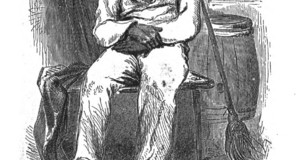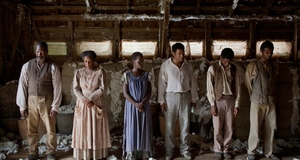Breaking the Cycle: Violence, Control & Resistance in American Slave Narratives
By
2010, Vol. 2 No. 01 | pg. 2/2 | « The notion of facing violence and death without fear is one that is common to many slave narratives. By accepting the possibility of death in their struggle, slaves reclaim a measure of influence over their own destiny. In addition, by refusing to be controlled by violence or threats of violence, slaves deplete the efficacy of their master’s tools of oppression. Though Douglass’s “turning point” involves him committing an act of violence himself, slave narratives represent multiple ways of undermining the brutality and injustice perpetrated against them. Resistance to violent oppression can be seen as taking three different forms: non-violent, violent and self-destructive, of which there are multiple examples of each. The commonality that unites all of these methods of resistance is the decision to refuse to be controlled by violence, even in the face of death. In her struggle to liberate her “sisters” Christine Stark relates such feelings of defiance. “And I will be free,” she writes, “and I will help women and girls escape, or I will die trying.”14 Non-violent resistance, though it does not involve the use of force on the part of the slave, is nevertheless just as dangerous and effective as other forms of resistance. In Our Nig, Frado achieves a victory over her mistress by refusing to carry a pile of wood into the house. Though Mrs. Belmont threatens to beat her savagely with a stick, Frado refuses to comply. “Stop,” she exclaims, “strike me, and I'll never work a mite more for you.”15 Mrs. Belmont desists and ultimately ends up carrying the load of wood herself. Frado thus discovers that she has the “power to ward off assaults” by refusing to be controlled by violence. This decision to resist, though it involves only the simple act of disobedience, nevertheless represents the acceptance of the possible violent consequences. By refusing Mrs. Belmont’s request, Frado discovers how to loosen her mistress’s hold over her; she comes to understand that Mrs. Belmont’s control is dependent upon violence and if she faces this threat of violence instead of bowing to it, she can regain a measure of control over her life. The refusal yield to violent oppression can also take the form retaliation, as is the case with Frederick Douglass. As Douglass writes after his fight with Mr. Covey, “I did not hesitate to let it be known of me, that the white man who expected to succeed in whipping, must also succeed in killing me.”16 Through this statement of defiance, Douglass indicates how he has become free from the physical violence and degradation inherent to the practice of whipping. “From this time,” he reports, “I was never again what might be called fairly whipped, though I remained a slave four years afterwards.”17 Douglass marks this act of violence and defiance as the moment of his liberation, though he is not freed until four years later. The decision to resist and risk death is a liberating one because it deprives the master’s use of violence of its potency. By resisting Covey, Douglass regains a measure of control and discovers a “turning point” towards eventual freedom.These types of defiance in the face of violence can also be taken one fatal step further by becoming acts of self-destruction. In William Wells Brown’s Clotel, self-violence is analyzed as a means of reclaiming control and achieving freedom. Towards the end of the narrative, Clotel, cornered by an angry mob, throws herself off a bridge to her death. “She clasped her hands convulsively,” Brown writes, “and raised them, as she at the same time raised her eyes towards heaven, and begged for that mercy and compassion there, which had been denied her on earth; and then, with a single bound, she vaulted over the railings of the bridge, and sunk for ever beneath the waves of the river!”18 In her final moments, Clotel is faced with the choice of re-enslavement or death. After offering up a hasty and desperate prayer to the heavens, she chooses certain death, launching herself into the Potomac. In doing so, Clotel re-claims control of her destiny in a final act of self-violence. In this instance, Brown equates freedom and death. In the elegiac poem that closes the chapter, the narrator celebrates this choice proclaiming, “ Joy! The hunted slave is free!”19 In addition, the title of the chapter itself is the simple declarative “Death is Freedom.” This title is not without irony, yet it still illustrates Clotel’s profound choice to face death. The fact that she would choose an act of self-destruction over re-enslavement serves to emphasize the horrid brutality of slave. The religious implications of Clotel’s choice are also profoundly significant. Facing re-enslavement, Clotel chooses suicide by throwing herself off the bridge, an act that would condemn her to hell by most Christian interpretations. Yet the narrator is highly sympathetic to her plight and implies the she may well receive freedom and mercy in the afterlife. “The form thou would’st fetter,” the poem reads, “returned to its God.”20 Here the notion of a “return to God” signifies her place in heaven; her tormenters can no longer “fetter” her and thus she ascends. In addition, Clotel’s pursuers are described as “fiends” and “demon forms,” implying the hellish nature of her earthly torment. “The universe holdeth no realm of night / More drear than her slavery,” Brown writes. This further reinforces Clotel’s experience of hell on earth, that there is no realm drearier than her state of slavery. The emphasis on Clotel’s earthly hell indicates that she will find freedom and relief from her suffering in death. This contrasts sharply with the sinful nature of suicide and suggests that Clotel’s final act of self-violence is justified and forgivable. On the whole, slave narratives do more than simply demonstrate the brutality of slavery. By representing acts of violence they demonstrate how violence comes to control the master. In addition, these narratives play out the possibility of rendering acts of violence ineffective as tools of oppression. From the nonviolent disobedience demonstrated in Our Nig, to the violent act of resistance in Frederick Douglass’s narrative, to the act of final self-destruction in Clotel, these narratives explore the possibility of depriving violent oppression of its power. Despite the brutality depicted, slave narratives also explore representations of violence that offered the opportunity for freedom. Through these various forms of resistance, slaves asserted their right and ability to chose their own destiny, even if it sometimes resulted in death. Works such as Clotel, Our Nig, Narrative of the Life of Frederick Douglass and many others go beyond simple promoting awareness of slavery’s violent essence; they represent and explore ways in which slaves might resist and undermine the brutal control exercised by their masters. ReferencesBrown, William Wells. Clotel: Electronic Version. Documenting the American South. http://docsouth.unc.edu/southlit/brown/brown.html, December 30, 2008. Douglass, Frederick. “Narrative of the Life of Frederick Douglass.” I Was Born A Slave. Ed. Yuval Taylor. Chicago: Lawrence Hill Books, 1999. Douglass, Frederick. The Life and Times of Frederick Douglass. Mineola, New York: Dover Publications, 2003. Gray, Thomas. “The Confessions of Nat Turner.” I Was Born A Slave. Ed. Yuval Taylor. Chicago: Lawrence Hill Books, 1999. Trodd, Zoe and Kevin Bales, Eds. “Introduction,” “Christine (United States, 2007).” To Plead Our Own Cause: Personal Stories by Today’s Slaves. Ithaca, New York: Cornell University Press, 2008. Walker, David. Appeal to the Colored Citizens of the World: Electronic Version. Documenting the American South. http://docsouth.unc.edu/nc/walker/walker.html, January 6, 2009. Wilson, Harriet. Our Nig; or Sketches in the Life of a Free Black. Electronic Text Center, University of Virginia Library. http://etext.virginia.edu/etcbin/toccer-new2?id=WilOurn. Endnotes1.) Douglass, Frederick. The Life and Times of Frederick Douglass. Mineola, New York: Dover Publications, 2003, pg. 279. 2.) Trodd, Zoe and Kevin Bales, Eds. To Plead Our Own Cause: Personal Stories by Today’s Slaves. Ithaca, New York: Cornell University Press, 2008, pg. 10. 3.) Trodd and Bales, pg. 10. 4.) Trodd and Bales, pg. 101. 5.) Walker, David. Appeal to the Colored Citizens of the World: Electronic Version. Documenting the American South. http://docsouth.unc.edu/nc/walker/walker.html, January 6, 2009, pg. 73-4. 6.) Wilson, Harriet. Our Nig; or Sketches in the Life of a Free Black. Electronic Text Center, University of Virginia Library. http://etext.virginia.edu/etcbin/toccer-new2?id=WilOurn.sgm&images=images/modeng 7.) Douglass, pg. 563. 8.) Douglass, pg. 565. 9.) Gray, Thomas. “The Confessions of Nat Turner.” I Was Born A Slave. Ed. Yuval Taylor. Chicago: Lawrence Hill Books, 1999, pg. 253. 10.) Ibid. 11.) Douglass, Frederick. “Narrative of the Life of Frederick Douglass.” I Was Born A Slave. Ed. Yuval Taylor. Chicago: Lawrence Hill Books, 1999, pg. 570. 12.) Douglass, pg. 570. 13.) Ibid. 14.) Trodd, Zoe and Kevin Bales, Eds. To Plead Our Own Cause: Personal Stories by Today’s Slaves. Ithaca, New York: Cornell University Press, 2008, pg. 102. 15.) Wilson, pg. 105. 16.) Douglass, Frederick. “Narrative of the Life of Frederick Douglass.” I Was Born A Slave. Ed. Yuval Taylor. Chicago: Lawrence Hill Books, 1999, pg. 570. 17.) Douglass, Frederick. “Narrative of the Life of Frederick Douglass.” I Was Born A Slave. Ed. Yuval Taylor. Chicago: Lawrence Hill Books, 1999, pg. 570. 18.) Brown, William Wells. Clotel: Electronic Version. Documenting the American South. http://docsouth.unc.edu/southlit/brown/brown.html, December 30, 2008, pg. 218. 19.) Brown, William Wells. Clotel: Electronic Version. Documenting the American South. http://docsouth.unc.edu/southlit/brown/brown.html, December 30, 2008, pg. 220. 20.) Brown, William Wells. Clotel: Electronic Version. Documenting the American South. http://docsouth.unc.edu/southlit/brown/brown.html, December 30, 2008, pg. 220. Suggested Reading from Inquiries Journal
Inquiries Journal provides undergraduate and graduate students around the world a platform for the wide dissemination of academic work over a range of core disciplines. Representing the work of students from hundreds of institutions around the globe, Inquiries Journal's large database of academic articles is completely free. Learn more | Blog | Submit Latest in History |


















